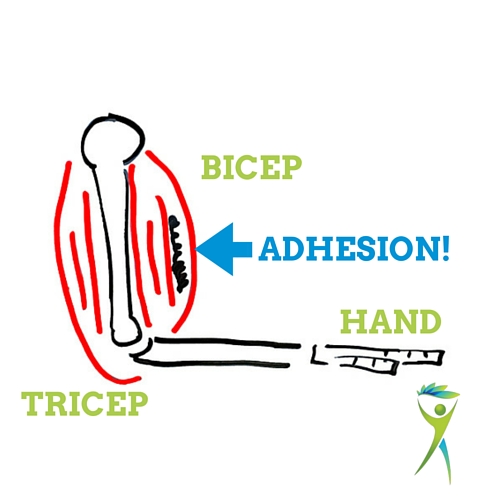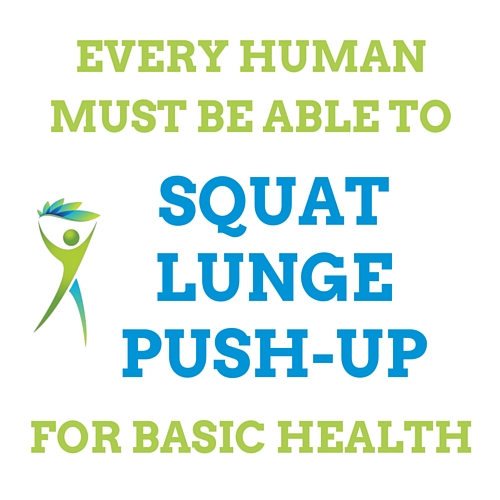
29 Feb The Soft Tissue Workout & Full Range of Motion Fitness: Part 2
Note: This post was inspired by my time discussing the soft tissue workout with News 12’s 12 to Your Health segment hosted by Dr. DeSilva in New Jersey. Part 1 can be read here. The term “soft tissue” can confuse people. It means any body parts that are soft. Your muscles are the easiest tissues to think about. For practical purposes, doing a “soft tissue workout” means preventing acute and chronic pain. In order to be officially legaled up ; ), use these principles and movements at your own discretion. Seek medical consult before starting.
Don’t be silly – read Part 1.
If you’re like most humans, you don’t care about preventing pain, until you’re in horrible pain. There’s something about human nature that we need pain to be really bad before we do anything differently.
Similarly, you don’t care about preventing heart disease, until your doctor says “You could have a heart attack soon.”
The pain of not being able to do what you love needs to be intense enough to warrant changing behavior. Hence, all of the recent research in behavioral psychology through the work of BJ Fogg and books like The Power of Habit (affiliate link : )) by Charles Duhigg.
Here, I assume that you want to get out of pain or want to lower the risk of pain for the remainder of your lifetime. That’s what keeping your soft tissue healthy is all about.
In Part 1 of the Soft Tissue Workout, we discussed:
- the prevalence of chronic pain in the American population (1 out of 13 people are currently experiencing pain that has lasted more than three months. This high percentage is unacceptable.)
- what soft tissue is and how healthy soft tissue prevents the deterioration and pain associated with aging
- the “house metaphor” for pursuing one’s fittest self
In Part 2, we discuss how to perform the most bang for your buck movements to restore integrity to your soft tissue and age well.
Principles for Reducing Adhesion in Your Soft Tissue
Moving or exercising to prevent pain warrants discussing purpose.
Your purpose might be to lose weight, build muscle, and do cardio. With that purpose, you can get by as you accumulate adhesion in your soft tissue and increase the risk of pain in the future.
Or, you can have the purpose of leveraging the soft tissue of your body through a full range of motion and respecting your body’s cues where it is at in the present moment. This can be achieved without giving your heart a desired workout stimulus.
However, it would be very difficult not to lose weight and build muscle when following the principles for reducing adhesion. The point is that focusing on reducing adhesion while moving or exercising spills over into other fitness areas that you will be happy to have addressed.
Here’s how breaking and preventing adhesion works.
You have a muscle, that may have adhesion in it. Take the bicep and your desire to diminish the risk of biceps tendonitis by reducing adhesion there.
To remove adhesion, you need to apply force to the adhesion in opposite directions to literally tear it.
Start moving it in a full range of motion with light weights and a slow tempo.

As you continue doing the movement with consistency, after a few days, you’ll notice greater range of motion and ease. After a few weeks, the adhesion should be significantly gone. After a few months, there should be no issue with the movement and the adhesion will be all but entirely removed.
If the movement hasn’t gotten easier, chances are there is an inconsistency in hitting the quota, the adhesion is too big for you to remove yourself, or there is a structural dysfunction present in all loaded tissues. You should either resume consistency with your movements or get a diagnosis from a qualified musculoskeletal provider.
Hit multiple birds with one stone by incorporating the rules below into your fitness routine. There’s minimal cost and large benefits to be achieved.
- Speed & Form: Be slow and coordinated when starting to build the right foundation for healthy movement.
- Range of Motion: Start in a comfortable, smaller range of motion. Your focus should be on pushing the boundaries of ease slightly. Be sure to understand, though, that the smaller the range of motion that a muscle is worked through, the higher the risk of developing adhesion. The goal is to work in as large of a range of motion as possible. For starting purposes, ease + form trump range of motion.
- Sets & Repetitions: Use the quota princple to achieve your mark by the end of the day. Movement does not need to be done in short duration workout form unless desired. Depending on fitness level, cookie-cutter prescriptions for nutritious movement is 20 reps for beginners, 50 reps for moderate fitness levels, and 100 reps for the fittest.
- Gradual Progression: Increase in range of motion and daily quota as ease increases and post-movement soreness decreases.
Bang for your Buck Adhesion-Preventing Movements
The two three-minute videos below discuss:
- Alpha Posture
- Air Squats
- Push-ups
- Lunges
These are the movements and postures that are the most bang-for-your-buck when it comes to preventing adhesion, increasing fitness, losing weight, and maintaining the ability to do what one loves. They make up the foundation for your movement routine and lifestyle.
Don’t even think about running, biking, swimming, or doing whatever activity you love until you are doing these four movements/postures as first priority.
How to Stand – The Alpha Posture
The Alpha Posture is how to conduct yourself through every second of every day. Gravity is always pushing your body into the ground from above. Because we have these really cool blocks in our spines called vertebra, we can stack up those blocks to minimize stabilizing muscle load and prevent adhesion build-up through posture. Not to fail to mention, standing like an “Alpha Male” or “Alpha Female” can change one’s neurology to display more confidence, strength, and pride.
Purpose:
- Minimize load to all stabilizing muscles of the spine, preventing overuse and adhesion build-up.
- Change your neurology to express more power in life when communicating with another individual, whether human or dog.
To stand as an alpha, notice all four corners of your feet being pushed into the ground. Keep your center of gravity over all four corners. Straighten your knees. Tuck your tailbone underneath you by squeezing your butt and pulling the front of your pelvis up towards your rib cage. Brace your belly as if someone was going to come punch you in the stomach. Pull your shoulders blades down into your back pockets. Tuck your chin in as if creating a double chin. Picture the crown of you head being pulled up to the sky.
How to Get Better at Sitting – The Squat
In Eastern countries, they have holes in the ground instead of toilets. Card games are played on the ground by squatting in a circle. They also have much lower incidence rates of knee, hip, and back pain. A first person account: My grandfather went to go to the bathroom one night (number two … so he had to sit), fell, and hit his head on the sink, and died a few hours later. He couldn’t squat. This doesn’t have to happen to you.
Purpose:
- Practice the motion of sitting and getting low to the ground as if to pick something up from it.
- Strengthen primarily our hamstrings and gluteal muscles (supposed to be the strongest muscles of our body that are able to handle moving our entirety through space).
- Stabilizing or locking the spine (keeping the core muscles tight as if somebody were about to punch you in the stomach).
- Lay strong foundation for sitting, bending, and lifting.
Stand with your feet at least shoulder width and point your feet slightly out. Start in the alpha posture and begin to move by unhinging your knees and sending your hips backwards. Push your butt back as far as you reasonably can knowing that you can stand back up. Your knees should be pointing in the same direction as your second toes and your heels should be pushed into the ground at all times. Rise by pushing your heels into the ground and stand tall.
How to Get Off the Ground – The Push-up
I once trained a 50-year old woman who would do exercises laying on her back on the ground. The first time she did this, she couldn’t get herself off the ground without using her hands to climb up nearby machines to stand up. I picked her up by giving her a hug and lifting her onto her feet. The ability to do a push-up allows you to lift your body off of the ground, get your feet beneath you, and stand. A much more efficient way to get off the ground.
Here’s how to do it (Courtesy of Mark’s Daily Apple). My only note in addition would be: Keep elbows at 45 degrees from the body to avoid overloading shoulders.
Purpose:
- Strengthen back, chest, and entire arms (everything above your hips).
- Stabilizing or locking the spine (keeping the core muscles tight as if somebody were about to punch you in the stomach)
- Lay strong foundation for any arm movements as well as the ability to get yourself off of the ground.
Take your standing alpha posture and tip it over horizontally until you’re in a plank position. Your feet should be touching each other and your tailbone should be tucked under. Your shoulders should be slightly “north” or over the top of your wrists. Keep your spinal alignment in the same orientation that you have while at the top of the plank position, completely with the chin tucked in. Bring your chest to the ground. Your elbows should be at a 45 degree angle from your torso (not 90 degrees like a body-buildnig push-up or 0 degrees like a yoga push-up or chaturanga. Push your whole hands into the ground as you come back to the plank position.
How to Walk Better – The Lunge
Many of us don’t run. If we run, we don’t sprint. If we don’t sprint, we lose the ability to use our body’s workhorses – hamstrings and glutes. In my chiropractic exams, if an athlete or runner cannot perform a proper lunge, I can almost guarantee they will eventually injure their knees, hips, and/or back.
Purpose:
- Maintain flexibility of hip flexors (front of hips) – vital for sedentary populations and back pain sufferers.
- Strengthen primarily our hamstrings, gluteal muscles, and adductors (groin).
- Stabilizing or locking the spine (keeping the core muscles tight as if somebody were about to punch you in the stomach).
- Lay strong foundation for walking, running, and sprinting.
Begin by standing in your alpha posture. Take a rather large step forward, forcing the load of your body weight onto your heel as you land. Slow yourself down and bring your back knee to the ground. At the bottom of the range of motion, your front knee should be at a 90 degree angle and pointed in the same direction as your second toe. Push back from the end range by pushing from your front heel back to standing.
If this is too difficult, start with the split-squat, which is a scaled-back, easier version of the lunge. In this movement, keep your feet stationary in the lunge stance, and simply move your body weight up and down without moving your feet front and back. With this movement, you’ll have to do all of the repetitions on the same leg before switching to the other leg.
Get Started with Your Soft Tissue Workout
Don’t overthink it.
Start performing the above movements for an easy amount of repetitions that add up to your quota by the end of the day. Don’t worry about range of motion. Only be concerned about form and moving slowly.
As your body adapts (which I guarantee that it will if you’re consistent), it’ll let you know with greater ease and less symptoms that you’re good to increase the range, sets, reps, and quota. Gradually increase the number as your comfort allows.
In a month of hitting your daily quota, I guarantee that you will move with greater range of motion and energy than you ever have before. Especially, if you have lived a sedentary lifestyle up to this point.
 What have you noticed by hitting your daily quota for exercise? Please share comments below.
What have you noticed by hitting your daily quota for exercise? Please share comments below.






The Soft Tissue Workout - Preventing and Finding Adhesion
Posted at 13:43h, 29 February[…] foundation of health and layering lesser ROI (return-on-investment) fitness attributes on top. In Part 2, we discuss the actual movements and how adhesion gets removed. […]
The Soft Tissue Workout & Full Range of Motion Fitness: Part 2 | Primal Docs
Posted at 14:51h, 29 February[…] The Soft Tissue Workout & Full Range of Motion Fitness: Part 2 […]
Ruairi Gallagher
Posted at 12:47h, 17 MayThank you for this article. Can you recommend any particular excersises for abdominal adhesions?
Dr. Chris
Posted at 17:27h, 17 MayTY very much. If the abdominal “muscle” adhesions are tiny, You can try some updog to see if they tear. If they’re bigger, you’ll need to see an adhesion specialist. You can try googling “Abdominal adhesion specialist” if it’s in the organs and get a massage. But I have no experience on the latter in the organs.